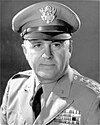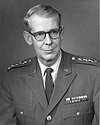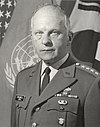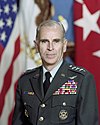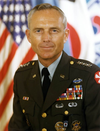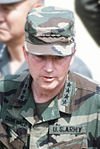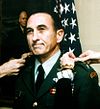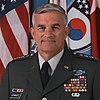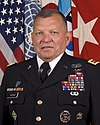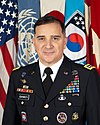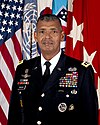How Many Service Member Families Are in South Korea
| Usa Forces Korea 주한 미군 | |
|---|---|
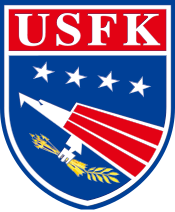 USFK | |
| Agile | 1 July 1957 – present |
| Country | |
| Type | Subordinate Unified Control |
| Size | 23,468 personnel |
| Office of | United States Indo-Pacific Command |
| Headquarters | Military camp Humphreys, Pyeongtaek, South Korea |
| Nickname(due south) | USFK |
| Website | world wide web |
| Commanders | |
| Current commander | General Paul J. LaCamera, USA |
| Deputy Commander | Lt Gen Scott 50. Pleus, USAF |
| Notable commanders | Full general Vincent K. Brooks Full general George Decker Full general Hamilton H. Howze General John W. Vessey General John A. Wickham |
| Insignia | |
| Distinctive unit insignia |  |
| Flag |  |
| U.s. Forces Korea | |
| Hangul | 주한미군 |
|---|---|
| Hanja | 駐韓美軍 |
| Revised Romanization | Juhanmigun |
| McCune–Reischauer | Chuhanmigun |
U.s.a. Forces Korea (USFK) is a sub-unified command of United states Indo-Pacific Command (USINDOPACOM). USFK is the joint headquarters through which U.Southward. combat forces would be sent to the fighting components nether the South korea/US (ROK/U.Southward.) Combined Forces Command (Cfc) – the combined ground, air, naval, marine and special operations forces component commands. Major USFK elements include 8th U.S. Army (EUSA), U.S. Air Forces Korea (Seventh Air Forcefulness), U.Due south. Naval Forces in Korea (CNFK), U.Southward. Marine Forces Korea (MARFORK) and Special Operations Command Korea (SOCKOR). It was established on July 1, 1957.
Its mission is to support the United nations Command (UNC) and Combined Forces Control past analogous and planning amidst U.Southward. component commands, and do operational control of U.S. forces as directed past United States Indo-Pacific Command.
USFK has Title 10 authority, which ways that USFK is responsible for organizing, training and equipping U.S. forces on the Korean Peninsula then that forces are agile, adjustable and prepare.
With 28,500 American soldiers, sailors, airmen and Marines in South korea,[ane] U.S. forces in Republic of korea are a major presence in the region and a key manifestation of the U.S. regime's aim to rebalance toward the Asia-Pacific. The USFK mission also includes planning non-combatant evacuation operations to ensure that if the demand arises, U.South. and other previously agreed-upon countries' citizens are removed from damage's manner. To this end, USFK conducts routine exercises to ensure that this process is effective, efficient, and orderly.
With the relocation of the new USFK and UNC headquarters to Camp Humphreys (in Pyeongtaek) on 29 June 2018, the USFK command and the bulk of its subordinate units take officially moved out of the city of Seoul; at present 35 km (22 mi) further south.[2]
Components [edit]
- Eighth Us Army; Headquarters: Army camp Humphreys, Republic of korea; authorized near xx,000 Soldiers
- 7th Air Force; Headquarters: Osan Air Base, South korea; authorized almost eight,000 Airmen
- Commander Naval Forces Korea (CNFK); Headquarters: Yongsan Garrison, Republic of korea; authorized near 300 Sailors
- Marine Forces Korea (MARFORK); Headquarters: Yongsan Garrison, South korea; authorized about 100 Marines
- Special Operations Command Korea (SOCKOR): Headquarters: Camp Kim, Yongsan, S Korea; authorized about 100 members
United Nations Command and Combined Forces Command [edit]


While USFK is a separate arrangement from United nations Command (UNC) and ROK/US Combined Forces Control (CFC), its mission is to back up both UNC and CFC past coordinating and planning among US component commands and providing U.s.a. supporting forces to the Chlorofluorocarbon. Equally such, USFK continues to support the ROK-US Common Defence force Treaty.
In response to the North Korean assail confronting South Korea on 25 June 1950, the Un Security Council (UNSC) established the UNC as a unified command nether the Usa in UNSC Resolution 84 on 7 July 1950. The UNC mission was to assist South korea to repel the attack and restore international peace and security in Korea. Throughout the war, 53 nations provided support to the UNC; sixteen nations provided combat forces and five sent medical and hospital units. Subsequently three years of hostilities, the commanders of both sides signed the Armistice Agreement on 27 July 1953.
Hostilities today are also deterred by this bi-national defense squad that evolved from the multi-national UNC. Established on 7 November 1978, the ROK/US Combined Forces Command (CFC) is the warfighting headquarters. Its role is to deter, or defeat if necessary, outside aggression against the ROK.
Commanders, U.S. Forces Korea [edit]
| No. | Commander | Term | Service branch | |||
|---|---|---|---|---|---|---|
| Portrait | Name | Took office | Left office | Term length | ||
| 1 | | Decker, GeorgeGeneral George Decker (1902–1980) | i July 1957 | thirty June 1959 | 1 year, 364 days |  U.South. Army |
| 2 | | Magruder, Carter B.General Carter B. Magruder (1900–1988) | i July 1959 | 30 June 1961 | ane year, 364 days |  U.South. Army |
| three | | Meloy, Guy Southward.Full general Guy S. Meloy (1903–1968) | one July 1961 | 31 July 1963 | two years, 30 days |  U.Due south. Army |
| 4 | | Howze, Hamilton H.Full general Hamilton H. Howze (1908–1998) | 1 August 1963 | 15 June 1965 | ane yr, 318 days |  U.South. Army |
| 5 | | Beach, Dwight Due east.General Dwight E. Beach (1908–2000) | sixteen June 1965 | 31 Baronial 1966 | 1 yr, 76 days |  U.S. Army |
| 6 | | Bonesteel, Charles H. IIIGeneral Charles H. Bonesteel Three (1909–1977) | 1 September 1966 | 30 September 1969 | three years, 29 days |  U.S. Regular army |
| seven | | Michaelis, John H.General John H. Michaelis (1912–1985) | 1 October 1969 | 31 August 1972 | ii years, 335 days |  U.S. Army |
| 8 | | Bennett, Donald V.Full general Donald 5. Bennett (1915–2005) | 1 September 1972 | 31 July 1973 | 333 days |  U.S. Regular army |
| nine | | Stilwell, Richard Grand.Full general Richard G. Stilwell (1917–1991) | 1 August 1973 | 8 October 1976 | 3 years, 68 days |  U.S. Army |
| 10 | | Vessey, John W. Jr.General John W. Vessey Jr. (1922–2016) | eight October 1976 | 10 July 1979 | 2 years, 275 days |  U.S. Regular army |
| 11 | | Wickham, John A. Jr.General John A. Wickham Jr. (born 1928) | 10 July 1979 | 4 June 1982 | ii years, 329 days |  U.S. Army |
| 12 | | Sennewald, Robert W.General Robert W. Sennewald (born 1929) | 4 June 1982 | 1 June 1984 | 1 year, 363 days |  U.Southward. Army |
| 13 | | Livsey, William J.General William J. Livsey (1931–2016) | i June 1984 | 25 June 1987 | 3 years, 24 days |  U.S. Army |
| 14 | | Menetrey, Louis C. Jr.General Louis C. Menetrey Jr. (1929–2009) | 25 June 1987 | 26 June 1990 | 3 years, one day |  U.S. Army |
| 15 | | RisCassi, Robert W.Full general Robert West. RisCassi (built-in 1936) | 26 June 1990 | fifteen June 1993 | two years, 354 days |  U.South. Army |
| 16 | | Luck, Gary E.General Gary E. Luck (built-in 1937) | 15 June 1993 | 9 July 1996 | 3 years, 24 days |  U.Due south. Army |
| 17 | | Tilelli, John H. Jr.Full general John H. Tilelli Jr. (born 1941) | 9 July 1996 | 9 December 1999 | three years, 153 days |  U.Southward. Army |
| eighteen | | Schwartz, Thomas A.General Thomas A. Schwartz (built-in 1945) | 9 December 1999 | 1 May 2002 | ii years, 143 days |  U.S. Army |
| 19 | | LaPorte, Leon J.Full general Leon J. LaPorte (born 1946) | i May 2002 | 3 February 2006 | 3 years, 278 days |  U.Southward. Regular army |
| 20 | | Bell, B.B.General B.B. Bell (born 1947) | iii February 2006 | iii June 2008 | 2 years, 121 days |  U.South. Army |
| 21 | | Abrupt, Walter Fifty.Full general Walter L. Sharp (born 1952) | iii June 2008 | xiv July 2011 | 3 years, 41 days |  U.S. Ground forces |
| 22 | | Thurman, James D.General James D. Thurman (built-in 1953) | 14 July 2011 | 12 Oct 2013 | 2 years, 80 days |  U.S. Army |
| 23 | | Scaparrotti, Curtis G.Full general Curtis M. Scaparrotti (built-in 1956) | two October 2013 | thirty April 2016 | two years, 211 days |  U.S. Army |
| 24 | | Brooks, Vincent G.General Vincent K. Brooks (born 1958) | 30 April 2016 | 8 Nov 2018 | 2 years, 192 days |  U.South. Army |
| 25 | | Abrams, Robert B.Full general Robert B. Abrams (built-in 1960) | viii Nov 2018 | 2 July 2021 | 2 years, 236 days |  U.Southward. Army |
| 26 | | LaCamera, Paul J.General Paul LaCamera (built-in 1963) | 2 July 2021 | Incumbent | 244 days |  U.Due south. Army |
History [edit]
The following is a partial list of border incidents involving North Korea since the Ceasefire Agreement of 27 July 1953, ended large scale armed services action of the Korean State of war. Most of these incidents took identify nigh either the Korean Demilitarized Zone or the Northern Limit Line. This list includes engagements on land, air and sea just does not include alleged incursions and terrorist incidents that occurred away from the border.
Many of the incidents occurring at sea are due to edge disputes. The North claims jurisdiction over a large area s of the disputed western maritime edge, the Northern Limit Line in the waters west of the Korean Peninsula. This is a prime fishing area, particularly for venereal, and clashes commonly occur. In addition, the North claims its territorial waters extend for 50 nautical miles (xc km) from the declension, rather than the 12 nautical miles (22 km) recognized past other countries. Co-ordinate to the five January 2011 Korea Herald, since July 1953 Due north Korea has violated the ceasefire 221 times, including 26 armed forces attacks.[three]
1950s [edit]
- 16 Feb 1958: North Korean agents hijack a South Korean airliner to Pyongyang en route from Pusan to Seoul; one American airplane pilot, one American passenger, two Due west German passengers and 24 other passengers were released in early March, but eight other passengers remained in the Northward.[4]
1960s [edit]
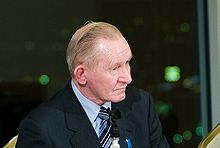
- May 1962: Pvt. Larry Allen Abshier abased his post in Republic of korea in May 1962 when he crept away from his base and crossed the DMZ into North korea. Abshier was the first to defect. Also in May 1962, Cpl. Jerry Parrish crossed the DMZ into Democratic people's republic of korea. His reasons for defecting, according to Jenkins' autobiography The Reluctant Communist, were "personal, and [Parrish] didn't elaborate about them much except to say that if he ever went dwelling house, his begetter-in-constabulary would impale him."[v]
- Aug 1962: James Joseph Dresnok was a Pfc. with a U.S. Army unit of measurement along the Korean Demilitarized Zone. Soon later on his arrival he found himself facing a court martial for forging signatures on paperwork that gave him permission to leave base of operations and which, ultimately, led to his existence AWOL (Absent Without Official Get out).[6] Unwilling to face up penalty, on fifteen August 1962, while his fellow soldiers were eating luncheon, he ran across a minefield in broad daylight into North Korean territory, where he was speedily apprehended by Due north Korean soldiers. Dresnok was taken by train to Pyongyang, the North Korean capital, and interrogated.[seven]
- 1964: N Korea creates an underground group: Revolution Party for Reunification. This group is footing downward and eliminated by S Korean government past 1969[eight]
- Jan 1965: Charles Jenkins, the most notable example, defected to Democratic people's republic of korea. In South Korea he was assigned to night patrols. As a issue of fears that he would exist transferred to combat duty in Vietnam, he grew depressed and anxious, and started drinking alcohol. On the night of 4 January 1965, afterwards reportedly drinking ten beers, he gear up off on his nightly patrol of the Demilitarized Zone. In the early morning he told his patrol that he was going to investigate a noise.[nine] He afterwards crossed into North korea and surrendered to forces in that location, in hopes of being sent to Russia and so, through prisoner exchange, somewhen returned to America. Presently thereafter North Korean propaganda declared that a U.Southward. sergeant had defected, and circulate statements allegedly made by the defector, reportedly in stilted English. The U.S. Ground forces claimed Jenkins wrote four messages stating his intention to defect (an accusation Jenkins denies); nonetheless, the original letters are reportedly lost. His relatives maintained throughout his absence that he was abducted.[nine]
- 27 April 1965: Two North Korean MiG-17s attack a United States EC-121 Alert Star reconnaissance aeroplane in the waters east of the Korean Peninsula, eighty km (l mi) from the North Korean shore. The aircraft was damaged, but managed to land at Yokota Air Base, Japan.[10] [11]
- 17 Jan 1968: In an incident known as the Blueish House Raid, a 31-homo detachment from the Korean People'south Army secretly crossed the DMZ on a mission to kill South Korean President Park Chung-hee on 21 January, nigh succeeding. The incursion was discovered afterwards Southward Korean civilians confronted the Due north Koreans and informed South Korean authorities. Afterwards entering Seoul disguised as South Korean soldiers, the North Koreans attempt to enter the Blue House (the official residence of the President of South Korea). They are confronted by South Korean police and a firefight ensued. The N Koreans fled Seoul and individually attempted to cross the DMZ back to North korea. Of the original group of 31 North Koreans, 28 were killed, 1 was captured and two are unaccounted for. Additionally, 68 South Koreans were killed and 66 were wounded, the majority of whom were soldiers and police force officers. Three American soldiers were as well killed and 3 were wounded.[12]
- 23 January 1968: The The states Naval ship the USS Pueblo is boarded and captured, forth with its crew, by North Korean forces in the waters east of the Korean Peninsula. The entire coiffure of 83 is captured, with the exception of 1 sailor killed in the initial attack on the vessel, and the vessel was taken to a North Korean port. All the captives were released on 23 Dec of the same year via the Bridge of No Render at the DMZ. The USS Pueblo is still in North Korean possession and is docked in Pyongyang and is on display as a museum ship.[xiii]
- thirty October 1968: From thirty Oct-ii November 120-130 North Korean commandos land on the northeast shore of Republic of korea, allegedly to establish a base of operations in order to wage a guerrilla war against the S Korean government. A total of 110-113 were killed, seven were captured and 13 escaped. Around 20 South Korean civilians, law enforcement officers and soldiers were killed.[xi] [14]
- March 1969: Six North Korean commandos kill a S Korean constabulary officeholder about Jumunjin, Gangwon-do. 7 American soldiers are killed in a North Korean attack along the DMZ.[15]
- April 1969: An EC-121, U.S. reconnaissance aeroplane is shot down 90 miles (140 km) east of the North Korean coast, leaving 31 dead.
- Nov 1969: Four U.Due south. soldiers are killed past North Koreans in the Demilitarized Zone.
1970s [edit]

- Apr 1970: In Geumchon, a region of Paju south of the DMZ, a clash leaves three North Korean soldiers dead and five Southward Korean soldiers wounded.
- June 1970: The North Korean navy seizes a circulate vessel from the Southward well-nigh the Northern Limit Line. 20 crewmen are captured.
- February 1974: Two Due south Korean fishing vessels are sunk and 30 crew detained by the North.
- 1974: The first tunnel into ROK is discovered (the three following tunnels were found in 1975, 1978, 1990)[viii]
- June 1976: An incursion south of the DMZ in Gangwon-practice leaves three dead from the North and six from the South.
- eighteen August 1976: The Korean axe murder incident—an endeavour to clear brush in the Demilitarized Zone about Panmunjom ends with ii U.S. soldiers dead.
- Oct 1979: Three N Koreans enter the eastern DMZ. Ane is killed.
- Dec 1979: I U.Due south. Regular army soldier killed, 3 U.Southward. soldiers wounded after stumbling into a Northward Korean minefield in a heavy fog while patrolling DMZ. One trunk is recovered from the North Koreans five days after.
1980s [edit]
- March 1980: Three North Koreans are killed while trying to cross the Han River estuary.
- May 1980: N Koreans appoint OP Ouillette on DMZ in firefight. One North Korean WIA.
- March 1981: Three Due north Koreans try to enter the South in Geumhwa-eup, Cheorwon, Gangwon-exercise; ane is killed.
- July 1981: Three North Koreans are killed trying to cross the Imjin River to the South.
- November 1984: Nine North Korean soldiers and one S Korean soldier dice, and one American soldier is wounded, during a firefight that erupted when a North Korean security detail chased a defecting Soviet citizen (Vasily Matusak) beyond the MDL into the southern-controlled sector of the Articulation Security Expanse.
- November 1987: Ane South Korean killed on DMZ primal sector past N Korean sniper fire.
1990s [edit]
- May 1992: Three North Korean soldiers in South Korean uniforms are killed in Cheolwon, Gangwon-do; three South Korean soldiers are wounded.
- December 1994: Northward Koreans shoot down US Army helicopter. One US KIA and i US Prisoner of war for thirteen days.
- May 1995: North Korean forces fire on a South Korean fishing gunkhole, killing 3 crewmen.
- October 1995: Two armed North Koreans are discovered at the Imjin River; one is killed.
- April 1996: Several hundred armed North Korean troops cantankerous repeatedly into the Demilitarized Zone.
- May 1996: Seven Northern soldiers cantankerous south of the Demilitarized Zone, but withdraw after warning shots are fired.
- May & June 1996: Due north Korean vessels twice cantankerous the Northern Limit Line and have a several-hour collision with the South Korean navy.
- April 1997: Five North Korean soldiers cross the Demilitarized Zone in Cheolwon, Gangwon-do, and fire on South Korean positions.
- June 1997: 3 North Korean vessels cross the Northern Limit Line and attack South Korean vessels two miles (3.2 km) s of the line. On land, 14 N Korean soldiers cross 70m south of the center of the DMZ, leading to a 23-minute exchange of fire.
- June 1999: A serial of clashes between Due north and Southward Korean vessels takes place in the waters west of the Korean Peninsula nearly the Northern Limit Line.
2000s [edit]
- 2001: On 12 separate occasions, Due north Korean vessels cross the Northern Limit Line and so withdraw.
- 27 November 2001: Due north and South Korean forces commutation burn down without injuries.
- 29 June 2002: Renewed naval clashes near the Northern Limit Line lead to the deaths of four South Korean sailors and the sinking of a South Korean vessel. The number of Northward Koreans killed is unknown.
- xvi November 2002: Due south Korean forces fire warning shots at a Northern boat crossing the Northern Limit Line. The gunkhole withdraws. A like incident is repeated on 20 Nov.
- 19 Feb 2003: A North Korean fighter plane crosses seven miles (xi km) south of the Northern Limit Line, and returns north after being intercepted by six Southward Korean planes.
- 2 March 2003: 4 North Korean fighter jets intercept a US reconnaissance airplane over the waters eastward of the Korean Peninsula.
- 17 July 2003: Due north and South Korean forces exchange fire at the DMZ effectually six:00 am. The Due south Korean ground forces reports four rounds fired from the North and 17 from the South. No injuries are reported.[xvi]
- 1 November 2004: North Korean vessels, claiming to be in pursuit of illegal fishing craft, cross the Northern Limit Line and are fired upon by the South. The vessels withdraw three hours later.
- thirty July 2006: Several rounds are exchanged most a South Korean mail in Yanggu, Gangwon.
- 10 November 2009: Naval vessels from the two Koreas exchanged fire in the area of the NLL, reportedly causing serious impairment to a North Korean patrol send.[17] For more details of this incident, come across Battle of Daecheong.
2010s [edit]
- 26 March 2010: A South Korean naval vessel, the ROKS Cheonan, was allegedly sunk by a N Korean torpedo most Baengnyeong Island in the waters west of the Korean Peninsula. A rescue operation recovered 58 survivors but 46 sailors died. On 20 May 2010 a South Korean-led international investigation group concluded that the sinking of the warship was in fact the result of a Northward Korean torpedo attack.[18] [nineteen] North korea denied involvement.[20] The United Nations Security Council fabricated a Presidential Statement condemning the assault but without identifying the attacker.[21]
- 23 November 2010: North Korea fired artillery at Republic of korea's Greater Yeonpyeong isle in the waters w of the Korean Peninsula and South korea returned fire. 2 South Korean marines and ii Southward Korean civilians were killed, six were seriously wounded and ten were treated for minor injuries. Approximately 70 South Korean houses were destroyed.[22] [23] [24] N Korean casualties were unknown, only Lee Hong-gi, the Director of Operations of the Due south Korean Joint Chiefs of Staff (JCS), claimed that equally a result of the Due south Korean retaliation "there may be a considerable number of Northward Korean casualties".[25]
- 2014: Some of the American forces that had withdrawn from South korea to take part in the Iraq invasion have been replaced past the nine-calendar month-long deployment of a battalion from the 1st Cavalry Division.[26]
- 2019: President Trump sought an increased Due south Korean contribution toward USFK costs from $830 million to almost $5 billion annually.[27] This was not agreed, and resulted in the furlough without pay of about 4,500 Due south Korean civilian staff in April 2020.[28]
Number of U.South. soldiers stationed in Due south Korea past year [edit]
| Twelvemonth | Number |
|---|---|
| 1950 | 510 |
| 1951 | 42,069 |
| 1952 | 326,863 |
| 1953 | 326,863 |
| 1954 | 225,590 |
| 1955 | 75,328 |
| 1956 | 68,813 |
| 1957 | 71,045 |
| 1958 | 46,024 |
| 1959 | 49,827 |
| 1960 | 55,864 |
| 1961 | 57,694 |
| 1962 | threescore,947 |
| 1963 | 56,910 |
| 1964 | 62,596 |
| 1965 | 58,636 |
| 1966 | 47,076 |
| 1967 | 55,057 |
| 1968 | 62,263 |
| 1969 | 66,531 |
| 1970 | 52,197 |
| 1971 | twoscore,740 |
| 1972 | 41,600 |
| 1973 | 41,864 |
| 1974 | xl,387 |
| 1975 | forty,204 |
| 1976 | 39,133 |
| 1977 | 40,705 |
| 1978 | 41,565 |
| 1979 | 39,018 |
| 1980 | 38,780 |
| 1981 | 38,254 |
| 1982 | 39,194 |
| 1983 | 38,705 |
| 1984 | xl,785 |
| 1985 | 41,718 |
| 1986 | 43,133 |
| 1987 | 44,674 |
| 1988 | 45,501 |
| 1989 | 44,461 |
| 1990 | 41,344 |
| 1991 | 40,062 |
| 1992 | 35,743 |
| 1993 | 34,830 |
| 1994 | 36,796 |
| 1995 | 36,016 |
| 1996 | 36,539 |
| 1997 | 35,663 |
| 1998 | 36,890 |
| 1999 | 35,913 |
| 2000 | 36,565 |
| 2001 | 37,605 |
| 2002 | 37,743 |
| 2003 | 41,145 |
| 2004 | 40,840 |
| 2005 | 30,983 |
| 2020 | 28,500 |
[29] [one]
Exercises [edit]
Each year the ROK, the The states and a selection of Sending States from the Un Control participate in multiple defense-oriented, combined and joint grooming events designed to defend the Republic of korea, protect the region, and maintain and increase stability on the Korean peninsula.

A U.S. Air Strength B-52 Stratofortress conducted a low-level flight in the vicinity of Osan Air Base, South Korea.
Ulchi-Liberty Guardian, Key Resolve, and Foal Eagle, in addition to multiple Rehearsal of Concept (ROC) Drills, are the three theater level exercises.
- Ulchi-Freedom Guardian (UFG) is an annual simulation driven, command transformation-oriented Command Post Exercise (CPX). Elements of the ROK and Usa governments participate, as well equally ROK and US forces from on and off the Korean peninsula. UFG integrates the annual ROK regime practise "Ulchi", which focuses on procedures for transitioning to war, government support. Ulchi also emphasizes ROK procedures for coordination between regime and military organizations from the national to local level. UFG typically incorporates the post-obit components: a Crisis Direction Exercise focused on strategic and operational decisions needed to defuse a crisis, or posture the command for successful execution of the advisable OPLAN if the enemy actions dictate; a Senior Leader Seminar (SLS) designed to foster senior-level give-and-take on a variety of topics related to crisis direction and war-fighting; and a 2-week Computer Assisted Practise that exercises the transition to war, defense, and counteroffensive phases of the war-fight. The exercise culminates in detailed senior leader level After-Action Reviews (AARs).
- Key Resolve (KR) is over the course of a two-calendar week-long CFC and ROK crisis management and war-fighting exercise. It provides invaluable opportunities to evaluate, train, and improves combined and joint coordination, procedures, plans and systems necessary for the conduct of contingency operations by ROK and Us forces. It is a simulation driven Command Post exercise that exercises the defense of the ROK and the ability of the United states of america to bring forces into the Theater of Operations to participate in that defense. The exercise culminates in detailed senior leader level AARs.
- Foal Eagle (Fe) is a serial of component-sponsored articulation and combined Field Training Exercises (FTX) that back up preparation of OPLAN related tasks via participation of selected off-peninsula units. Atomic number 26 demonstrates United states of america power projection and rapid deployment capabilities and is conducted concurrently, just not linked to, the KR CPX. Tactical units are the principal Fe FTX training audition exercising all aspects of CFC's mission; rear area security, back up operations, RSOI, special operations, basis maneuver, expeditionary operations, air gainsay operations, and maritime operations.
In June 2018 the South korea and the U.s. claimed they are ready to stop the conducting of war machine drills in society to create significant opportunities for the negotiations with DPRK.[30]
Shoulder sleeve insignia [edit]
Description [edit]
A shield-shaped embroidered device three+ 1⁄8 inches (7.nine cm) in height and 2+ 1⁄2 inches (6.four cm) in width overall blazoned: azure, in chief 4 mullets bendwise argent, all above a stylized American baldheaded eagle, issuant from sinister base of operations volant to dexter chief; the eagle's body gules surmounted by two bendlets, wider at base, of the 2nd throughout; head of the second, eyed of the field, leg and talons of the 2nd grasping a laurel co-operative and seven arrows or. The entire shield shape is edged with a 1⁄16 -inch (0.xvi cm) white border. Attached in a higher place the device is a designation band in scarlet inscribed "USFK" in white letters. The unabridged device is edged with a one⁄eight -inch (0.32 cm) blueish edge.
Symbolism [edit]
The shield shape reflects the United states Forces Korea's steadfast delivery to defend the sovereignty of S Korea. The abbreviation "USFK" stands for United States Forces Korea which activated on one July 1957. The four stars symbolize the service and contributions of the United States Army, United States Navy, United states Air Forcefulness, and the U.s.a. Marine Corps. The stylized American bald hawkeye represents cohesion and unity among the services. The laurel sprigs and arrows describe the mission of the United States Forces Korea to defeat assailment if necessary. Red, white, and blue are the colors of the flag of the United states of america of America. Red symbolizes hard work and award, white represents innocence and purity, and blue refers to justice and perseverance. Yellow signifies wisdom and intuition.
Background [edit]
The shoulder sleeve insignia was approved on 18 June 2012. (TIOH Dwg. No. A-1-1077).[31]
Controversy [edit]


Gwangju Uprising [edit]
The 1980s marked a surge in anti-Americanism in Korea, widely traced to the events of May 1980.[32]
Gwangju convinced a new generation of young [Koreans] that the democratic movement had developed not with the support of Washington, as an older generation of more conservative Koreans thought, but in the face up of daily American back up for whatever dictator who could quell the democratic aspirations of the Korean people. The result was an anti-American movement in the 1980s that threatened to bring down the whole structure of American support for the ROK. American cultural centers were burned to the basis (more than one time in Gwangju); students immolated themselves in protest of Reagan's support for Chun [Doo-hwan].[33]
Fundamental to this motility was a perception of U.Southward. complicity in Chun'due south ascension to power, and, more than particularly, in the Gwangju massacre itself. These matters remain controversial. It is clear, for instance, that the U.Southward. authorized the Korean Army's 20th Segmentation to re-take Gwangju – as acknowledged in a 1982 letter to the New York Times by then-Administrator Gleysteen.
[General Wickham], with my concurrence, permitted transfer of well-trained troops of the twentieth R.O.K.A. Division from martial-police duty in Seoul to Gwangju because law and gild had to be restored in a situation that had run amok following the outrageous beliefs of the Korean Special Forces, which had never been under Full general Wickham's command.[34]
Even so, every bit Gwangju Insurgence editors Scott-Stokes and Lee notation, whether the expulsion of government troops left the situation lawless or "amok" is very much open to dispute.
21st century [edit]
In 2002, anti-American sentiment in Due south Korea spiked after ii U.S. soldiers in an M60 armored vehicle-launched bridge (AVLB) accidentally striking and killed two Due south Korean teenage girls in the Yangju highway incident.[35]
An expansion of Camp Humphreys afterwards in the decade served as a catalyst for the Daechuri Protests, drawing thousands of South Korean citizens,[36] resulting in occasional tearing clashes and arrests.[37] Following a serial of large protests against the U.S. and Republic of Korea governments' programme to expand Camp Humphreys and make information technology the main base for most U.S. troops in Southward Korea, residents of Daechuri and other small villages virtually Pyeongtaek agreed to a regime settlement to leave their homes in 2006 and allow the base'due south expansion.[38] [39] Bounty for the state averaged 600 meg won (near U.s.$600,000) per resident.[forty]
During the COVID-nineteen pandemic, members of USKF, and other strange nationals were reported to have no-mask parties at Haeundae Beach in Busan for the Independence Day of 2020,[41] and the Memorial Day of 2021, amongst the local social distancing restrictions.[42]
Relationships between U.S. soldiers and South Korean women [edit]
Western princesses (prostitutes servicing U.S. soldiers) have resulted in a negative epitome for South Korean women who have relationships with American men.[43] [44]
Run into besides [edit]
- Republic of Korea Armed Forces
- Korean People's Army
- Korean Augmentation To the United states Regular army
- Usa Forces Nihon (USFJ)
- United States Taiwan Defence Command (USTDC)
- Listing of United States Army installations in South korea
- U.S.–Southward Korea Condition of Forces Agreement
- United states Army Armed services Regime in Korea (1945–1948)
- Mutual Defense Treaty Betwixt the United States and the Democracy of Korea
- Aftermath of the Korean War
- Division of Korea
- 38th parallel north
References [edit]
- ^ a b Work, Clint (25 August 2020). "How to Constructively and Safely Reduce and Realign US Forces on the Korean Peninsula". 38 North. The Henry 50. Stimson Middle. Retrieved 25 August 2020.
- ^ UNC and USFK Open New Headquarters Building Retrieved two July 2018
- ^ "N.M. Commits 221 Provocations Since 1953". Korea Herald. 5 January 2011.
- ^ Dick K. Nanto (18 March 2003). "Report for Congress, Due north Korea: Chronology of Provocations, 1950 - 2003" (PDF). Federation for American Scientists . Retrieved 3 April 2015.
- ^ The Reluctant Communist. Charles Robert Jenkins (University of California Press) p. 34
- ^ Russell, Marking (19 October 2006), "An American in North Korea, Pledging Allegiance to the Great Leader", New York Times , retrieved 28 January 2007
- ^ Anderson, Robert G.; Casey Morgan (28 January 2007). "Joe Dresnok: An American in Democratic people's republic of korea". hr. CBS News. Retrieved 27 July 2013.
- ^ a b Seth, Michael. "12 North Korea: Recovery, Transformation, and Decline, 1953 to 1993". A History of Korea: History to Antiquity. Rowman & Littlefield Publishers.
- ^ a b "Deserter Recalls N. Korean Hell". CBS News.
- ^ "Cold War Shootdowns". Retrieved 9 December 2007.
- ^ a b "N Korean Provocative Actions, 1950 - 2007" (PDF). United States Congress. 20 Apr 2007. Retrieved ix December 2007.
- ^ Daniel, Bolger. "3: A Continuous Nightmare" (PDF). Scenes from an Unfinished War: Low-Intensity Disharmonize in Korea, 1966-1968 (PDF). Control and General Staff College. Retrieved 10 December 2007.
- ^ "Pueblo". Dictionary of American Naval Fighting Ships. Usa Navy. Archived from the original on 8 December 2010. Retrieved 10 December 2007.
- ^ "filtration of North Korean Commando Troops into Ulchin-Samchok Surface area". Koreascope. 31 August 2006. Retrieved 12 December 2007.
- ^ "7 GIs Die in Korean DMZ Fighting". The Hartford Courant. 17 March 1969.
- ^ "North, Southward Trade Fire Along DMZ". VOA News. Archived from the original on 26 October 2007. Retrieved 2 August 2006.
- ^ Kim, San (x November 2009). Koreas disharmonism in the waters west of the Korean Peninsula, blame each other. Yonhap.
- ^ Foster, Peter; Moore, Malcolm (20 May 2010). "N Korea condemned by earth powers over torpedo attack". Daily Telegraph. London. Retrieved 20 May 2010.
- ^ Park In-kook (4 June 2010), "Letter dated iv June 2010 from the Permanent Representative of the Republic of korea to the United Nations addressed to the President of the Security Council" (PDF), United Nations Security Council, S/2010/281, retrieved xi July 2010
- ^ "Press Conference on Situation in Korean Peninsula: DPRK Permanent Representative to the Un Sin Son Ho". Department of Public Information. United nations. 15 June 2010. Retrieved eleven July 2010.
- ^ "Presidential Statement: Attack on South korea Naval Send 'Cheonan'". United Nations Security Council. United Nations. 9 July 2010. S/PRST/2010/13. Retrieved 11 July 2010.
- ^ "북한 해안포 도발 감행, 연평도에 포탄 100여발 떨어져". Chosun Ilbo. 23 November 2010. Retrieved 23 November 2010.
- ^ "GLOBAL MARKETS: European Stocks Seen Lower on Korea News". The Wall Street Journal. 23 November 2010.
- ^ Gabbatt, Adam (23 November 2010). "North Korea fires on South Korea – live coverage". The Guardian. London.
- ^ Gwon, Seung-jun (23 Nov 2010). "합참 "우리 군 대응사격으로 북한 측 피해도 상당할 것"". The Chosun Ilbo . Retrieved 23 November 2010.
- ^ SHANKER, THOM (7 January 2014). "Boosted U.S. Battalion Going to South Korea". world wide web.nytimes.com . Retrieved 7 Jan 2014.
- ^ Bosco, Joseph (24 January 2020). "South korea and the billion mustache". The Hill. Washington DC. Retrieved 21 April 2020.
- ^ Kuhn, Anthony (i Apr 2020). "U.Southward. Military In Republic of korea Faces Double Blow Of Korean Staff Furloughs And COVID-19". National Public Radio. Retrieved 22 April 2020.
- ^ Kane, Tim (24 May 2006). "Global U.South. Troop Deployment, 1950-2005". The Heritage Foundation. The Heritage Foundation. Retrieved ix April 2018.
- ^ "U.s. to suspend armed services exercises with South Korea, Trump says". TheGuardian.com. 12 June 2018.
- ^ The Plant of Heraldry
- ^ http://www.eroseffect.com/articles/neoliberalismgwangju.htm#_ednref71 Neoliberalism and the Gwangju Uprising
- ^ Bruce Cumings in Lee Jai-Eui, Gwangju Diary. University of California, 1999. p. 27
- ^ quoted in The Gwangju Uprising. Ed. Henry Scott-Stokes and Lee Jai-Eui, Eastward Gate Publishing, 2000. p. 231
- ^ "Anti-United states of america protests grow in Seoul". BBC News. 8 December 2002. Retrieved thirty June 2012.
- ^ Franklin Fisher (13 May 2006). "Turmoil, barbed wire surround rice fields". Stars and Stripes . Retrieved xxx June 2012.
- ^ "Ten injured in protestation well-nigh U.Southward. military machine base". Joongang Daily. viii August 2005. Retrieved 30 June 2012.
- ^ "Ceremonies accolade residents driven from lands slated for Humphreys expansion". Stars and Stripes. Retrieved ix April 2007.
- ^ "S. Koreans rally at Camp Humphreys fence to protest U.South. presence". Stars and Stripes. Retrieved 10 August 2005.
- ^ "Daechuri outcome sees no resolve". The Hankyoreh. Retrieved 2 Jan 2012.
- ^ "U.S. military officials in Korea apologize after July 4th party gets out of paw". The Washington Post. 7 July 2020.
- ^ "USFK members, foreigners agree no-mask parties on Busan beach amid pandemic". Yonhap News Agency. 30 May 2021.
- ^ Sung So-young (thirteen June 2012). "The actual reality of interracial relationships". Joongang Daily. Retrieved thirteen April 2013.
- ^ Kim, Soe-jung (23 October 2005). "Forum tackles overseas marriages". Joongang Daily. Retrieved 12 April 2013.
External links [edit]
- U.s. Forces Korea (USFK) official website
- U.S. Forces, Korea / ROK-US Combined Forces Control (globalsecurity.org)
- U.S. Naval Forces Korea official website
- 8th Fighter Wing, Kunsan Air Base official website
- 51st Fighter Wing, Osan Air Base official website
- "Northern Limit Line (NLL) West Sea Naval Engagements". Globalsecurity.org . Retrieved 1 Baronial 2006.
- Nanto, D.K. (xviii March 2003). "North Korea: A Chronology of Provocations, 1950-2003" (PDF) . Retrieved ane August 2006.
Source: https://en.wikipedia.org/wiki/United_States_Forces_Korea
